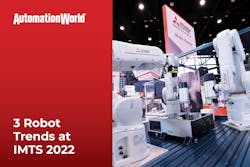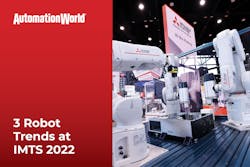
Quick hits:
- How the spread of cobots enables the automation of machine tending tasks.
- The automation of robot path planning to avoid collisions in tight work cells with multiple robots.
- Welding becomes a more common task for cobots.
Related to this episode:
Welcome to Automation World’s Technology Matters. I’m David Greenfield, Director of Content, and today I’m going to share some insights on robotic trends I saw at this year’s IMTS event in Chicago.
IMTS has long been held every two years in Chicago—but this was the first event since 2018 due to COVID. The show, which is dedicated to manufacturing technologies, featured more than 85,000 registrants and more than 1,800 exhibitors in Chicago’s McCormick Place. And with so much on display, it can be difficult to say what was most interesting. But for the Automation World audience, here are three developments I noticed that should pique your interest.
This first involves the use of robots for machine tending. When it comes to automating tasks, one of the first areas targeted tend to be repetitive tasks that require precision and dexterity. But machine tending, which is of course, a repetitive and precise task, has largely remained a manual operation because robotic systems tended to be too expensive for such uses. But that’s been changing with the spread of collaborative robots, or cobots, across industry.
The lower price point of cobots, combined with their more intuitive programming requirements and ability to be moved where needed to work alongside humans with no protective fencing, has resulted in machine tending developing into a major application for cobots.
At IMTS 2022, Universal Robots showcased several machine tending applications developed by partners using Universal Robots’ cobots. For now, I’ll highlight the machine tending applications from Robotiq and VersaBuilt.
The software used in the machine tending application from Robotiq reportedly reduces the time that it takes to program the system by 65 percent. Nick Garcia with Robotiq said that, in just three steps the software will generate a template program by asking what type of operation is being performed—whether it's a mill or a lathe; then it prompts the user to program key waypoints for the robot within it; and then Robotiq’s Smart Moves software automatically programs the robot’s path based on those waypoints.”
Anders Beck with Universal Robots also highlighted a system from VersaBuilt for machine tending that makes it easier for machinists to change parts, which is an increasingly common task for high mix, low-volume manufacturers. He said with this robotic machine tending system from VersaBuilt, it's possible for a machinist to retool the process frequently for many different parts. The ability to do this frees up people from being tied to machine processes so they can, instead, be preparing new parts, replacing parts, or programming the robot to handle new parts.
The second point of interest from IMTS is how the idea behind cobots being able to work alongside humans has captured so much attention that some companies have been working on bringing collaborative capabilities to industrial robots.
At IMTS, we saw an update from Realtime Robotics that expands on the work the company is doing with Mitsubishi Electric Automation and Kawasaki Robotics.
Alejandro Suarez with Realtime Robotics explained how their RapidPlan Create and RapidPlan Realtime software are used to control Mitsubishi’s Assista cobot as well as two of its industrial robots in an assembly operation involving screw driving.
Suarez said users only have to program the robots to place the screws where needed. From there, the Realtime Robotics software will compute the best path possible for the robots and avoid any collisions that could occur as the three robots work together in a small space.
In another demonstration at IMTS, Tom Munger explained how Realtime Robotics technology can be used to control robots in automotive spot-welding applications. In this exhibit, two Kawasaki Robotics’ BX100N robots were outfitted with ARO spot weld guns.
Here, Munger pointed out how closely the robots can operate next to each other without colliding. He said: With RapidPlan, it's not just one single motion that exists for each robot. Instead, the software pre-calculates thousands of motions that each one of those robots can use dynamically.
The final robot trend to note from IMTS in this video is the growing use of cobots for welding applications. Universal Robots’ has been highlighting this capability for a few years, and now ABB showcased its six-axis GoFa cobot’s welding capability.
ABB’s Matthew Conklin explained that the GoFa’s intrinsic safety means that it requires no guarding and its block-style programming makes it easier for beginners to learn robot programming. And the actual code created by the block-style programming interface can be accessed so that users can see the underlying code created to advance their knowledge of robot programming.
So I hope you enjoyed this Technology Matters episode. Keeping watching this space for regular updates on advances in and applications of industrial automation technology.
